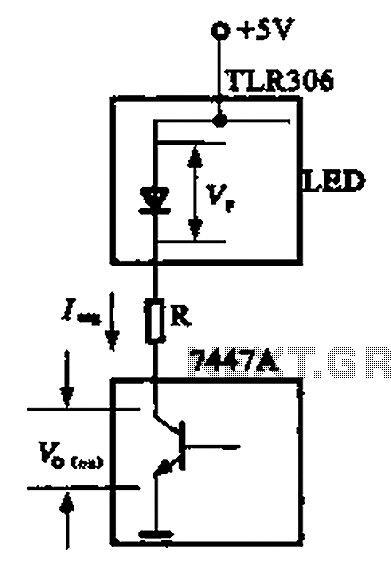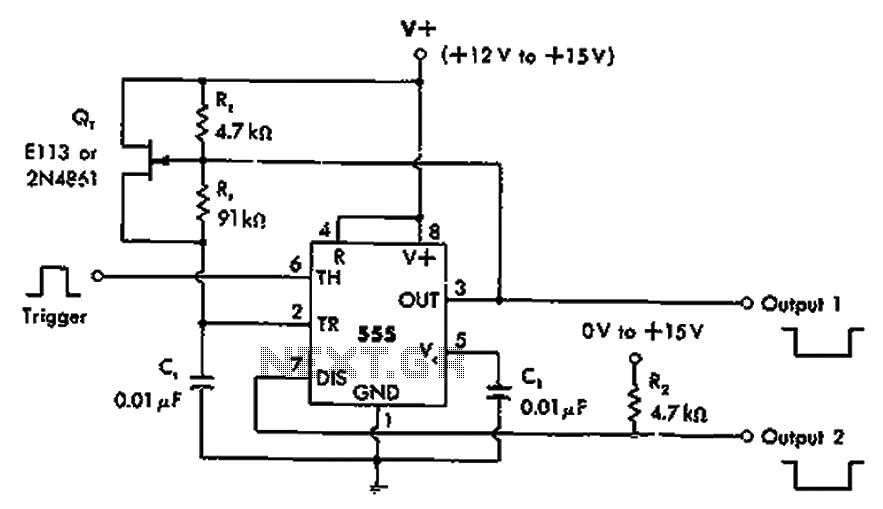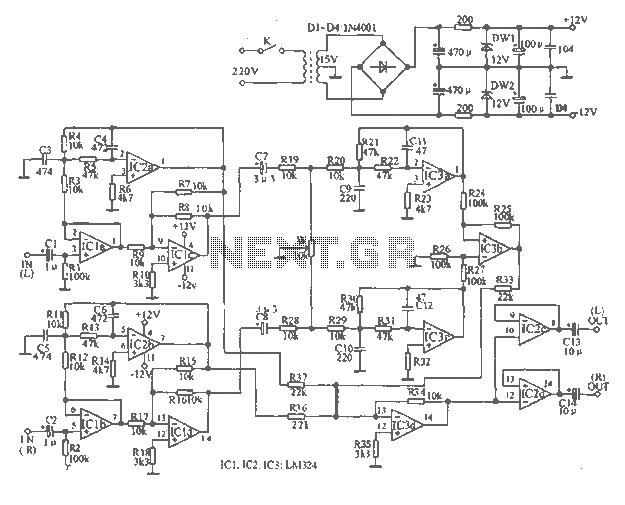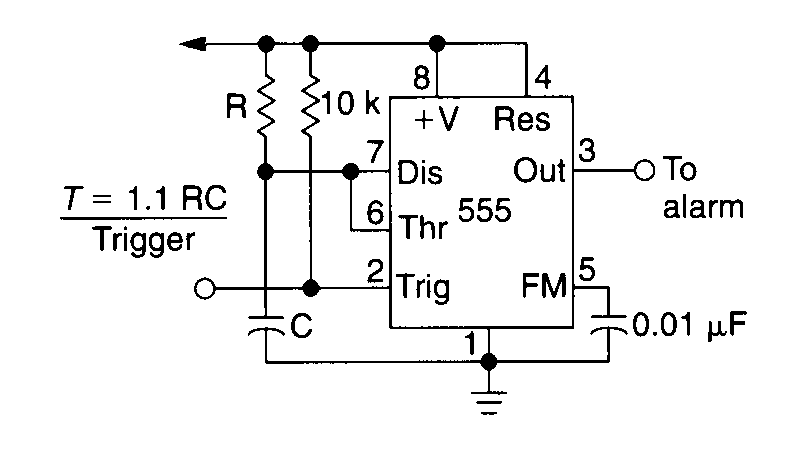
12VDC to 230VAC 60W Inverter Circuit
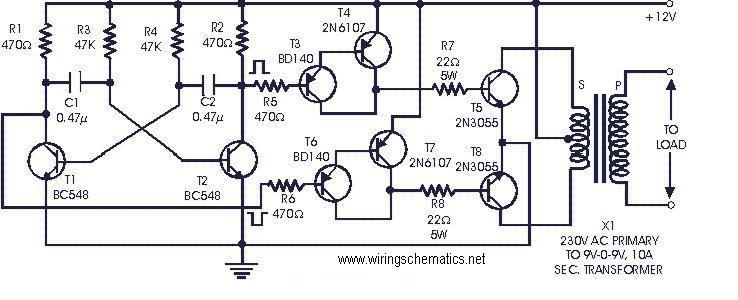
The following circuit is a cost-effective, fully transistorized inverter circuit suitable for driving medium loads in the range of 40 to 60 watts, operating with a 12V, 15 Ah battery or a larger power capacity. Transistors T1 and T2 (BC548) form a 50Hz multivibrator. To achieve the correct frequency, the values of resistors R3 and R4 may require adjustment after testing. The complementary outputs from the collectors of transistors T1 and T2 are sent to PNP Darlington driver stages created by the transistor pairs T3-T4 and T6-T7 (utilizing transistors BD140 and 2N6107). The outputs from these drivers are connected to transistors T5 and T8 (2N3055), which are configured for push-pull operation. Increased wattage can be achieved by enhancing the drive to the 2N3055 transistors by reducing the values of resistors R7 and R8 while increasing their power rating. Appropriate heat sinks should be used for the output stage transistors to prevent overheating. Transformer X1 is a 230V primary to 9V-0-9V, 10A secondary, utilized in reverse.
The described inverter circuit employs a multivibrator configuration using two BC548 transistors (T1 and T2) to generate a square wave signal at a frequency of 50Hz. This frequency is crucial for the inverter's operation, and the resistors R3 and R4 play a significant role in determining the oscillation frequency. After initial testing, these resistor values may need to be fine-tuned to ensure optimal performance.
The output from the collectors of T1 and T2 is fed into two Darlington pairs formed by transistors T3-T4 and T6-T7, which are BD140 and 2N6107, respectively. The Darlington configuration provides high current gain, which is essential for driving the larger power transistors (T5 and T8). The 2N3055 transistors are configured in a push-pull arrangement, allowing the inverter to efficiently convert the DC voltage from the battery to an AC output suitable for driving loads.
To enhance the output capability of the inverter, the drive to the 2N3055 transistors can be increased. This can be achieved by lowering the resistance values of R7 and R8, which would allow more base current to flow into T5 and T8. However, it is important to ensure that these resistors can handle the increased power dissipation, necessitating the use of higher wattage ratings.
Thermal management is a critical aspect of the design, as the output transistors can generate significant heat during operation. Therefore, suitable heat sinks should be attached to the 2N3055 transistors to maintain their operating temperature within safe limits, thus preventing thermal runaway and ensuring reliability.
The transformer (X1) is a key component, with a primary winding rated for 230V and a secondary winding of 9V-0-9V at 10A. This transformer is used in reverse to step up the voltage from the inverter's output to the desired AC voltage level. The design effectively utilizes the transformer to provide isolation and voltage transformation, making it suitable for various applications where a stable AC supply is required from a DC source. Overall, this inverter circuit presents a practical solution for powering medium loads efficiently and economically.The following circuit is a cheap completely transistorised inverter circuit ideal for driving medium loads with the order of 40 to 60 watts working with battery of 12V, 15 Ah or larger power capacity. Transistors T1 and T2 (BC548) make a 50Hz multivibrator. For having right frequency, the values of resistors R3 and R4 might need to be modified aft er testing. The complementary outputs from Collectors of transistors T1 and T2 are provided to PNP darlington driver phases created by transistor pairs T3-T4 and T6-T7 (utilising transistors BD140 and 2N6107). The outputs from the drivers are fed to transistors T5 and T8 (2N3055) connected for push-pull operation.
Somewhat bigger wattage can be accomplished by growing the drive to 2N3055 transistors (by lowering the value of resistors R7 and R8 while raising their wattage). Suitable heatsinks may be applied for the output stage transistors to keep the transistor from overheating.
Transformer X1 is really a 230V primary to 9V-0-9V, 10A secondary used in reverse. 🔗 External reference
The described inverter circuit employs a multivibrator configuration using two BC548 transistors (T1 and T2) to generate a square wave signal at a frequency of 50Hz. This frequency is crucial for the inverter's operation, and the resistors R3 and R4 play a significant role in determining the oscillation frequency. After initial testing, these resistor values may need to be fine-tuned to ensure optimal performance.
The output from the collectors of T1 and T2 is fed into two Darlington pairs formed by transistors T3-T4 and T6-T7, which are BD140 and 2N6107, respectively. The Darlington configuration provides high current gain, which is essential for driving the larger power transistors (T5 and T8). The 2N3055 transistors are configured in a push-pull arrangement, allowing the inverter to efficiently convert the DC voltage from the battery to an AC output suitable for driving loads.
To enhance the output capability of the inverter, the drive to the 2N3055 transistors can be increased. This can be achieved by lowering the resistance values of R7 and R8, which would allow more base current to flow into T5 and T8. However, it is important to ensure that these resistors can handle the increased power dissipation, necessitating the use of higher wattage ratings.
Thermal management is a critical aspect of the design, as the output transistors can generate significant heat during operation. Therefore, suitable heat sinks should be attached to the 2N3055 transistors to maintain their operating temperature within safe limits, thus preventing thermal runaway and ensuring reliability.
The transformer (X1) is a key component, with a primary winding rated for 230V and a secondary winding of 9V-0-9V at 10A. This transformer is used in reverse to step up the voltage from the inverter's output to the desired AC voltage level. The design effectively utilizes the transformer to provide isolation and voltage transformation, making it suitable for various applications where a stable AC supply is required from a DC source. Overall, this inverter circuit presents a practical solution for powering medium loads efficiently and economically.The following circuit is a cheap completely transistorised inverter circuit ideal for driving medium loads with the order of 40 to 60 watts working with battery of 12V, 15 Ah or larger power capacity. Transistors T1 and T2 (BC548) make a 50Hz multivibrator. For having right frequency, the values of resistors R3 and R4 might need to be modified aft er testing. The complementary outputs from Collectors of transistors T1 and T2 are provided to PNP darlington driver phases created by transistor pairs T3-T4 and T6-T7 (utilising transistors BD140 and 2N6107). The outputs from the drivers are fed to transistors T5 and T8 (2N3055) connected for push-pull operation.
Somewhat bigger wattage can be accomplished by growing the drive to 2N3055 transistors (by lowering the value of resistors R7 and R8 while raising their wattage). Suitable heatsinks may be applied for the output stage transistors to keep the transistor from overheating.
Transformer X1 is really a 230V primary to 9V-0-9V, 10A secondary used in reverse. 🔗 External reference

